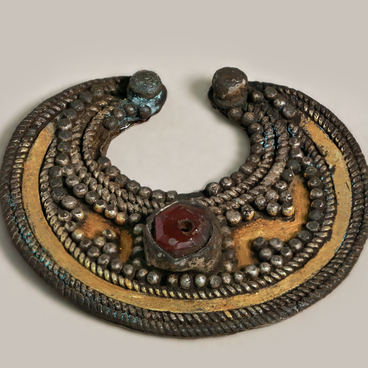The Khanty decorated traditional women’s clothing not only with beads, colored broadcloth, rovduga (suede) and fur mosaics. Special metal castings were also made for decoration.
The decorations displayed at the exhibition “Ugra Heritage” are identical in shape and size to the decorations that were made by the Yugan Khanty at the end of the 19th century. Prototypes of such castings are found in medieval burials; it is likely that the form of the decoration was passed down from generation to generation. Cast decorations on the Khanty clothes can be seen in the album “Ethnographic Description of the Peoples of Russia”, which was published in 1862 in St. Petersburg. Then, the Khanty were called the Ostyaks.
In addition to the castings, archaeologists also find casting molds that craftsmen cut with a knife from a piece of wood, bark, and less often from soft slate. An ingot of metal was heated in a pot over a fire, and then poured into a mold.
Such decorations were made from tin, because it is easy to melt, and it has a light color. In the culture of the Khanty, products made of light-colored metal had a sacred meaning and performed a protective function. Castings were sewn along the sides, collar and along the hem of sak — unfastened clothing. These decorative elements were separated by two beaded stripes. Sometimes, the castings were edged with stripes of multi-colored broadcloth. Such metal adornments were characteristic exclusively of Khanty women’s clothing. Warm outerwear, shirts and dresses were also decorated with castings. Also, women could embroider the collars of children’s clothes with tin decor.
By the beginning of the 20th century, fashion had changed and women from the eastern group of the Khanty switched to other decorative elements — coins and buttons. By the end of the 20th century, ornamental beaded stripes became popular. Today, the Khanty women almost never use homemade metal stripes to decorate traditional clothing, preferring more affordable materials.
The decorations displayed at the exhibition “Ugra Heritage” are identical in shape and size to the decorations that were made by the Yugan Khanty at the end of the 19th century. Prototypes of such castings are found in medieval burials; it is likely that the form of the decoration was passed down from generation to generation. Cast decorations on the Khanty clothes can be seen in the album “Ethnographic Description of the Peoples of Russia”, which was published in 1862 in St. Petersburg. Then, the Khanty were called the Ostyaks.
In addition to the castings, archaeologists also find casting molds that craftsmen cut with a knife from a piece of wood, bark, and less often from soft slate. An ingot of metal was heated in a pot over a fire, and then poured into a mold.
Such decorations were made from tin, because it is easy to melt, and it has a light color. In the culture of the Khanty, products made of light-colored metal had a sacred meaning and performed a protective function. Castings were sewn along the sides, collar and along the hem of sak — unfastened clothing. These decorative elements were separated by two beaded stripes. Sometimes, the castings were edged with stripes of multi-colored broadcloth. Such metal adornments were characteristic exclusively of Khanty women’s clothing. Warm outerwear, shirts and dresses were also decorated with castings. Also, women could embroider the collars of children’s clothes with tin decor.
By the beginning of the 20th century, fashion had changed and women from the eastern group of the Khanty switched to other decorative elements — coins and buttons. By the end of the 20th century, ornamental beaded stripes became popular. Today, the Khanty women almost never use homemade metal stripes to decorate traditional clothing, preferring more affordable materials.
Tin decorations from the ethnographic collection of the Nefteyugansk History and Art Museum Complex — 46 castings — were made and used in the 20th century. The items were found near the Khanty settlement in the upper reaches of the Samsonovka River, not far from the village of Salym.



